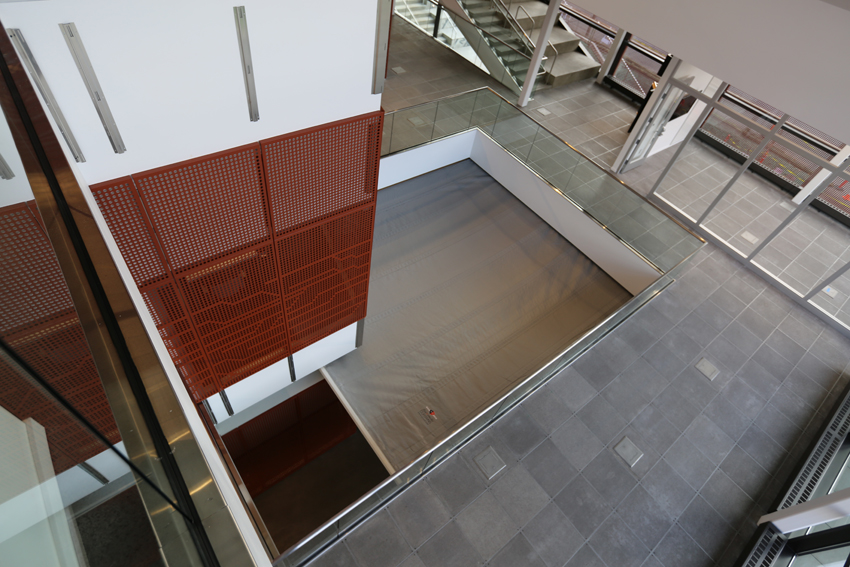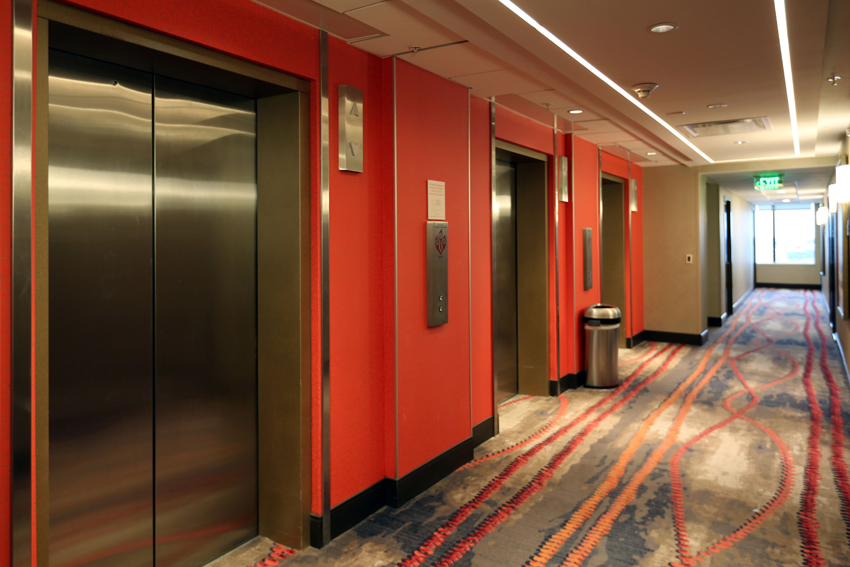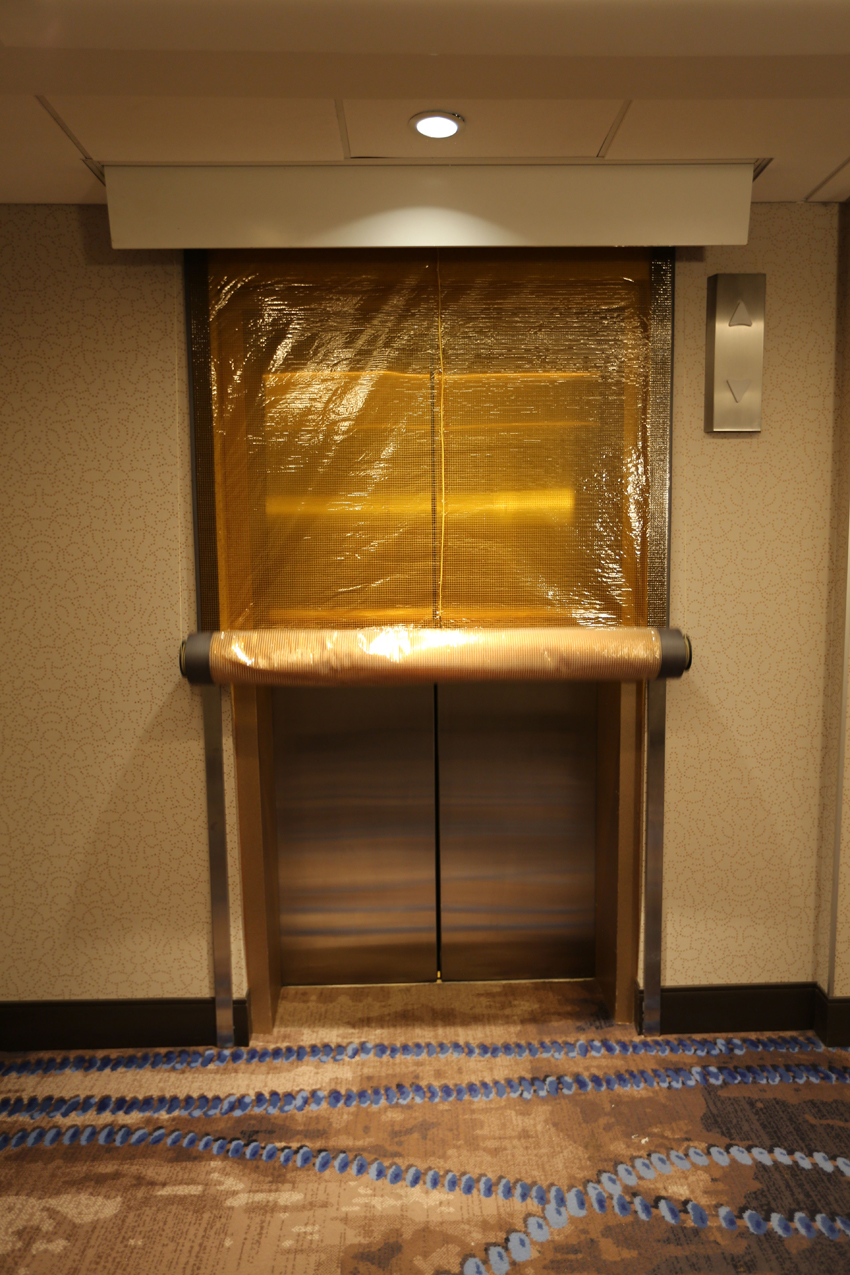Deployable Fire- and Smoke-Protection Solutions
REQUIRED SMOKE CONTAINMENT IN ATRIUM AND MULTISTORY SPACES
Vertical smoke migration must be considered in other types of interior space beyond the elevator hoistway. The code demands that some degree of smoke protection be incorporated into open, multistory space—whether it is an atrium, a two-story opening, or an open stairway. Interestingly, the specific fire- and smoke-protection measures required in these similar but different types of space can depend upon the type of occupancy and even the way that the architect chooses to define the feature in the floorplan.
Consider this. A 15-foot by 20-foot multistory space in an apartment building that connects only the first and second floors could be classified as either an atrium or a two-story opening. An atrium is defined in Section 202 of the IBC as an “opening connecting two or more stories other than enclosed stairways, elevators, hoistways, escalators, plumbing, electrical, air-conditioning, or other equipment, which is closed at the top and not defined as a mall. Stories, as used in this definition, do not include balconies within assembly groups or mezzanines that comply with Section 505.” A two-story opening is defined, in Section 712.1.9, as a feature that does not connect more than two stories, does not penetrate a smoke compartment, and is not open to a corridor in an I or R occupancy. Section 1020.1 requires a fire-rated separation of an egress corridor in an R occupancy.
The way that the project architect chooses to refer to this type of space can have a dramatic impact on the type and expense of the fire and smoke protection that must be incorporated into it. If the opening is considered an atrium, it would not require a smoke-control system but would require a fire-rated separation from adjacent spaces. Section 404.5 requires a means of smoke control. This system can be either active or passive, although many architects assume that a mechanical smoke-evacuation system is necessary in an atrium. This is an example of a multistory space that does not require a smoke-control system. Section 404.6, Exception 3 allows an atrium to be open to three stories, providing the smoke-control system is designed for it. If the feature is considered a two-story opening, as defined in the IBC, the opening will have to be separated from any corridors and also any occupied spaces. In short, the two-story opening in this scenario would have to be separated from anything.
As an apartment building, it may be advantageous to call this opening an atrium because it would not require a smoke-control system but would require a fire-rated separation from corridors.
But, if the function of this scenario is changed from an apartment building to an assisted-living facility, which is an occupancy group I-1, it would be better to call the feature a two-story opening. With just the change in occupancy type, suddenly the atrium would require smoke control, which, even to outfit the small 15-foot by 20-foot multistory space, could cost $500,000. If it is called a two-story opening instead of an atrium, it would still require the fire-rated separation from corridors, as detailed in Section 1020.1 and Section 712.1.9, and it could not connect smoke compartments, but all of these could be accomplished simultaneously with just a fire-rated separation.
This scenario perfectly illustrates how something as simple as an occupancy change can have an enormous effect on the level and expense of the smoke-protection system that is required by code.
Traditional Multistory Passive Smoke-Containment Solutions
Architects often take a deep breath when they think about incorporating a smoke-evacuation system into a project. It is not that these systems are particularly space-guzzling or complex to incorporate, but they are tremendously expensive, easily costing upward of $1 million. When a code requires smoke control on a project, the compliant systems can be mechanical or passive.
Passive smoke-containment solutions compartmentalize the area and prevent smoke migration. These systems are traditionally divided into one of two categories: permanent or deployable. A permanent smoke-containment solution is permanently in place whether there is an emergency or not. Examples of permanent passive smoke-containment solutions include walls and protective glass that can effectively stop the trespass of smoke across the assembly. However, as trends demand more open space, these permanent constructions, while effective, hamper design.
As architects look for a way to create safe, code-compliant interiors that are open, they need solutions that will provide smoke protection when there is a fire event, without being an ever-present eyesore that compartmentalizes the space during the typical day-to-day. They are seeking deployable fire- and smoke-rated curtains.
New Deployable Fire- and Smoke-Rated Curtains
Fire- and smoke-rated curtains are often divided into three categories: vertical, horizontal, and perimeter. Their category refers to how the curtains are used to divide and protect a space. Vertical curtains create a vertical barrier that can be used to quadron off the central atrium or multistory space from the corridors that flank it, keeping smoke from traveling from the atrium into the corridor or from the corridor into the atrium. Horizontal curtains can be used to reduce the size of a multistory atrium. For example, a three-story atrium can be divided into a two-story space and a one-story space with a horizontal curtain deployed through the opening. A perimeter curtain can be perfectly tailored to frame the shape of the open space. Each of these systems offers designers a deployable solution that creates open space that is equipped with the code-mandated fire- and smoke-rated protectives.

The horizontal fire curtain deploys to provide an opening protective in multistory openings and atriums.
Vertical Fire- and Smoke-Rated Curtain
Vertical fire- and smoke-rated curtains are, as the name suggests, rated for fire and smoke control. Manufactured from a filament glass fabric, vertical curtains have a 2-hour (120-minute) fire-endurance rating from the UL 10D standard and are compliant with the UL 1784 standard for smoke and draft control in assemblies.
These vertical curtains can protect openings in walls, subdivide atriums, and safely separate other specialty enclosures where fire-rated protection is required.
Horizontal Fire-Rated Curtain
Fire-rated horizontally deploying curtains can bisect an atrium between floors, compartmentalizing space. This can be a cost-effective and code-compliant way to avoid a mechanical smoke evacuation system that might otherwise be necessary for the project. The horizontal fire curtain satisfies IBC requirements to provide an opening protective in atrium and lightwell applications.
Perimeter Fire-Rated Curtain
A fire-rated perimeter curtain is a unique fire-rated barrier that can accommodate any number of opening shapes and sizes. The system can be configured in an open shape, such as an L or U, or as a closed shape like a square or hexagon. Another distinguishing feature of a perimeter curtain is that is does not require a corner post, allowing the perimeter curtain to descend into an opening free from structural supports. These curtains are stored in a headbox (193/8 inches deep by 9 inches high) that is typically installed above the ceiling and runs off a building’s standby power system.











